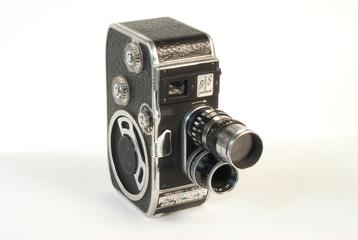Main body of Technicolor camera by Technicolor Ltd
Main body of Technicolor three strip camera, made in America by the Technicolor Motion Picture Corporation about 1932. Magazine cover missing, Serial No DE12, c. 1932.
More
Technicolor, introduced in 1915, is regarded as the finest colour motion picture process. It evolved through four versions, culminating in this three-colour camera, which used a beam splitter behind the lens with red, green and blue filters to record the primary colours on three separate monochrome films.
The camera has two film gates. The green separation is recorded onto a negative through a green filter directly behind the lens. At right-angles to the lens were two additional negatives placed back to back (a bi-pack arrangment) that received light through a magenta (i.e. a combination of red and blue) filter. The film which recorded the red separation was panchromatic, like that used to recorded the green separation, but the other was orthochromatic, only sensitive to blue and green, so it only recorded the blue part of the magenta light. Its base was dyed orange to filter out the blue so that only red light was received by the panchromatic film behind it.
Subsequently, a dye matrix positive was made from each processed negative on bichromated gelatin film. These reproduced all the tones as different levels of hardened gelatin - the highlights were clear of gelatin. These matrices were then dyed with the subtractive primaries, yellow (for blue negative), magenta (for green negative) and cyan (for red negative) and used to make the colour print.
The first three colour Technicolor production was Walt Disney's cartoon 'Flowers and Trees' in 1932.
- Measurements:
-
overall: 650 mm x 350 mm x 800 mm, 79 kg
- Materials:
- steel (metal) , aluminium alloy , rubber (unidentified) , glass and leather
- Object Number:
- 1968-707/1
- type:
- technicolor camera








